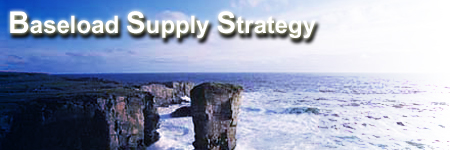


To ensure a combined constant output for the purpose of supplying baseload electricity, the speed of the marine current and the time at which the peak speeds occur at each site are dominant in selecting the best sites to install the Marine Current Turbine schemes. However, other constraints relating to the geographical position of each site must also be assessed to ensure the sites are suitable for installing turbine schemes of the required size and the supply strategy is realistically achievable.
The aim of this section was to evaluate each site based upon a list of site-specific criteria applying constraints relating to; the transmission network, marine areas that must be avoided, the nature of the seabed, conflicts that may arise with existing sea users and the risk of collision to seagoing vessels. After each site was assessed, areas were selected around each site which were considered to be suitable for the installation and operation of MCTs.
| Transmission Network |
Constraints References
Constraints
Other than the technology itself required to capture the marine current energy, the biggest technological constraint is how to deliver the generated electricity to the paying customer. Many of the coastal areas of high-current velocities identified are in remote locations where no major transmission or distribution infrastructure exists. In this case, the sizes of schemes planned of around 30MW and greater will require direct connection to the 175kV transmission systems or significant reinforcement and up rating of the sub-transmission and distribution networks.
Therefore, the distance to the point of connection to the existing network will have major effects on the cost of grid connecting any marine current turbine scheme. This may involve installing sub-sea cables, underground cables, or overhead lines and the required transformer to up-rate the voltage of the power generated to the current grid voltage level.
The existing UK transmission system is already working to capacity in many areas, therefore the available capacity of the sections of the transmission systems closest to the proposed marine current turbine scheme or farms must be identified. Where capacity i.e. agreed voltage levels, fault levels or power flow levels, may be exceeded reinforcement of overhead lines, protection systems and other transmission plant may be required (adding to the overall cost).
Also, as any rollout of the planned baseload supply strategy would not begin until around 2008 – when the turbine technology is scheduled to become commercially available – so the planned reinforcement by utility companies and additional generation that may be added to the power system, e.g. onshore & offshore wind farms, must be taken into account when estimating distance to point-of-connections available capacities and any reinforcements required.
back to top
References
- S P Transmission, Scottish & Southern Energy plc, National Grid (2003), Distribution and Renewable Energy Transmission Study.
- S P Transmission & Distribution, Scottish & Southern Energy plc (2001), Impact or Renewable Generation on the Electrical Transmission Network in Scotland, Scottish Executive Renewable Energy Network Study Group.